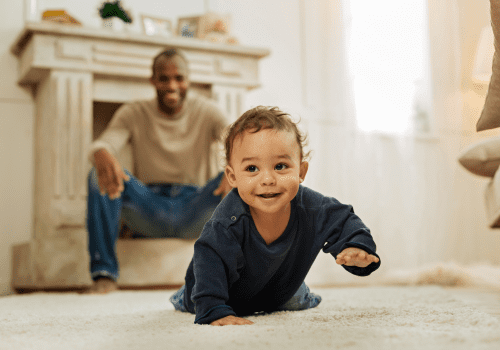
Milestones: Crawling (6-10 months)
Of all the “firsts”, walking is one milestone parents are most excited for and worry the most about. Before baby starts walking from place to place it is vital he or she has spent some time on all fours, crawling. If your child has missed crawling they may have skipped some important developmental steps that may cause issues later. Don’t worry if this is the case because there are things you can do to help them.
Most parents accept that crawling is a milestone, but many do not realize why it is so important. Typically, around six to ten months babies begin to crawl. Your baby may also opt for other methods of movement around this time such as shuffling or scooting on her bottom, using a hand and foot to propel forward, pushing forward or backward on his tummy, or rolling across the room. Moving in these ways is okay for a short period of time while they are building muscle strength, but they need to experience crawling on all fours. If those movements patterns continue and baby does not crawl on all fours they will miss out on important developmental signals. To help your baby get ready for his crawling debut provide him lots of supervised tummy time. Some babies begin to experiment with crawling on their bellies. They may scoot forward or backward on the floor using their arms and legs to move themselves around. Belly crawling does not take as much strength or balance to perform but prepares them for crawling on their hands and knees, in a cross-crawl pattern. Babies may start rocking back and forth on all fours while muscle strength develops but eventually should move the opposite arm and leg to move forward.
Why crawling is important?
Criss-cross crawling allows babies to create connections between both sides of the brain. Crawling in this fashion by using opposite limbs of the body is important later in life when performing difficult tasks such as walking, running, passing one object from one hand to the other, problem solving, or taking notes in class while listening. Crawling in a crisscross pattern forces both sides of the brain to communicate, coordinate, and develop in a balanced way.
Other ways crawling in a cross-crawl pattern helps:
- Increases lower back strength
- Development of the lumbar spinal curve
- Reshapes the hip sockets by pulling them inward and forward so baby can later position and balance himself for walking.
- Improves hand-eye coordination
- Improves learning and problem solving
Limit use of devices & props
Sensory and motor function is restricted when baby is unable to move freely and get into positions on his own. Despite parents’ best intentions, putting babies in devices can slow a baby’s pathway to mobility. Instead of making their muscles stronger and creating proper spinal and hip development sitting too early has the opposite effect – it prevents the muscles needed for movement to be strengthened. This doesn’t mean you should avoid these tools completely but limit their use for short periods of time only.
How can we encourage crawling?
- Tummy time
- Allow your baby to sit and belly crawl when baby is ready. Baby will build the strength and coordination to crawl on all fours when the muscles and joints are ready.
- Reduce props or devices that keep baby upright and limit baby’s ability to move independently
- Massage the back and legs to reduce muscle tension that may be present due to prolonged postures in devices.
If you notice your baby is not crawling in the criss-cross pattern, then it may be time to seek the help of a healthcare professional. Remember that early intervention can correct a problem early versus reacting to poor behaviors that are established and take longer to correct. There are many strategies available that can help baby optimize function and address any issues that may be present.
–Melanie Dockter, DC CACCP



